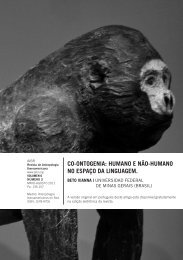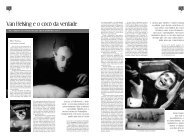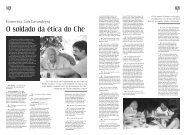Merleau-Ponty, 1964. Eye and mind. - Biolinguagem
Merleau-Ponty, 1964. Eye and mind. - Biolinguagem
Merleau-Ponty, 1964. Eye and mind. - Biolinguagem
- No tags were found...
Create successful ePaper yourself
Turn your PDF publications into a flip-book with our unique Google optimized e-Paper software.
individuals, then, bound together externally by causality. As far as the thing <strong>and</strong> its mirror<br />
image are concerned, their resemblance is only an external denomination; the<br />
resemblance belongs to thought. The dubious relationship of likeness is—among things<br />
—an unequivocal relationship of projection.<br />
The Cartesian does not see himself in the mirror; he sees a puppet, an "outside," which,<br />
he has every reason to believe, other people see in the very same way, but which is no<br />
more for himself than for others a body in the flesh. His "image" in the mirror is an effect<br />
of the mechanics of things. If he recognizes himself in it, if he thinks it "looks like him," it<br />
is his thought that weaves this connection. The mirror image is in no sense a part of him.<br />
For him, icons lose their powers. 19 However vividly an etching may "represent" forests,<br />
towns, men, battles, storms, it does not resemble them. It is only a bit of ink put down<br />
here <strong>and</strong> there on the paper. A figure flattened down onto a plane surface scarcely retains<br />
the forms of things; it is a deformed figure that must be deformed—the square becomes a<br />
lozenge, the circle an oval—in order to represent the object. It is an image only as long<br />
as it does not resemble its object. If not through resemblance, how, then, does it work It<br />
"excites our thought" to "conceive," as do signs <strong>and</strong> words "which in no way resemble the<br />
things they signify. " 20 The etching gives us sufficient indices, unequivocal "means" for<br />
forming an idea of the thing that does not come from the icon itself; rather, it arises in us,<br />
as "occasioned" by the icon. The magic of intentional species—the old idea of effective<br />
resemblance so strongly suggested to us by mirrors <strong>and</strong> paintings—loses its final<br />
argument if the entire potential of a painting is that of a text to be read, a text totally free<br />
of promiscuity between the seeing <strong>and</strong> the seen. We need no longer try to underst<strong>and</strong><br />
how a painting of things in the body could make them felt in the soul—an impossible task,<br />
since the very resemblance between this painting <strong>and</strong> those things would have to be<br />
seen in turn, since we would "have to have other eyes in our <strong>mind</strong>s with which to<br />
apperceive it," 21 <strong>and</strong> since the problem of vision remains intact even after we have<br />
introduced these simulacra, w<strong>and</strong>ering between things <strong>and</strong> us. What the light casts upon<br />
our eyes, <strong>and</strong> thence upon our brain, does not resemble the visible world any more than<br />
etchings do. Nothing goes from things to the eyes, <strong>and</strong> from the eyes to vision, no more<br />
than from things to a blind man's h<strong>and</strong>s, <strong>and</strong> from his h<strong>and</strong>s to his thoughts.<br />
Vision is not the metamorphosis of things themselves into the sight of them; it is not a<br />
matter of things' belonging simultaneously to the world at large <strong>and</strong> a little private world. It<br />
is a thinking that unequivocally decodes signs given within the body. Resemblance is the<br />
result of perception, not its basis. Thus, the mental image, the visualization which renders<br />
present to us what is absent, is a fortiori nothing like a breakthrough to the heart of Being.<br />
It too is a thought relying upon bodily indices—this time insufficient ones—which are<br />
made to say more than they mean. Nothing is left of the oneiric world of analogy….<br />
What interests us in these famous analyses is that they make us aware of the fact that<br />
every theory of painting is a metaphysics. Descartes does not say much about painting,<br />
<strong>and</strong> one might think it unfair on our part to make so much of a few pages on engravings.<br />
And yet the very fact that he speaks of painting only in passing is itself significant.<br />
Painting for him is not a central operation contributing to the definition of our access to<br />
Being; it is a mode or a variant of thinking, where thinking is canonically defined as<br />
intellectual possession <strong>and</strong> self-evidence. His very brevity is the indication of a choice; a<br />
closer study of painting would lead to a different philosophy. It is significant, too, that<br />
when he speaks of "pictures" [tableaux] he takes line drawings as typical. We shall see<br />
that the whole of painting is present in each of its modes of expression; there is a kind of<br />
drawing, even a single line, that can embrace all of painting's bold potential.<br />
But what Descartes likes most about engravings is that they preserve the form of objects,<br />
or at least give us sufficient signs of their forms. They present the object by its outside, or<br />
8









